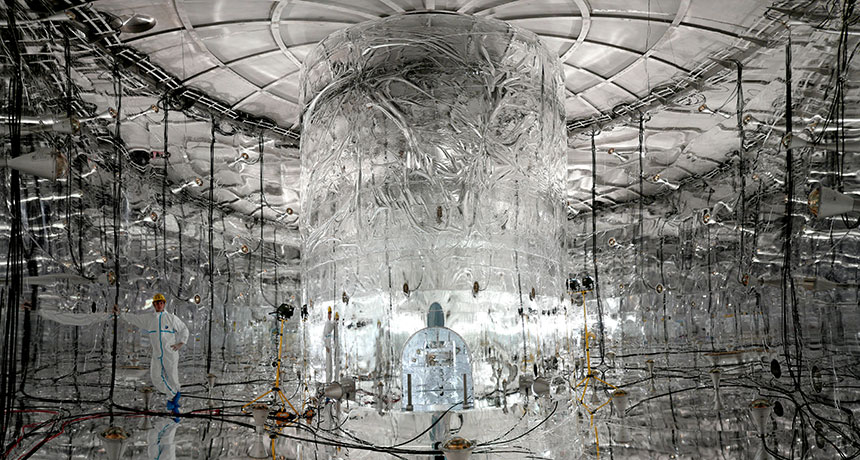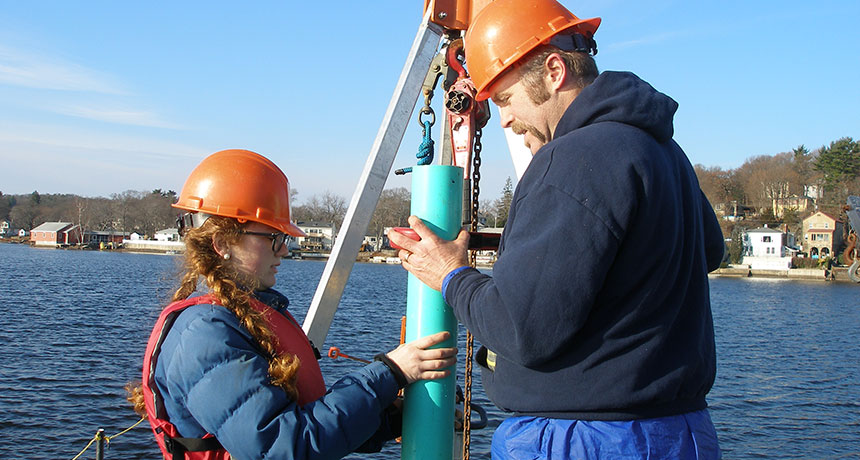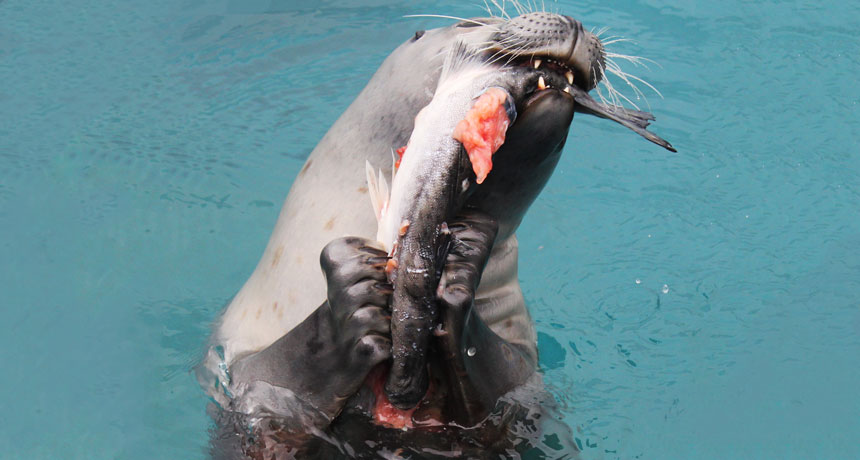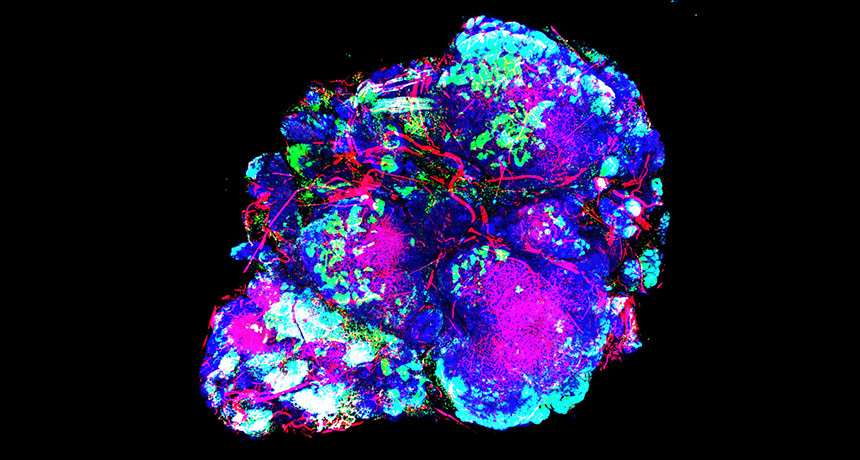The quest to identify the nature of the neutrino’s alter ego is heating up

Galaxies, stars, planets and life, all are formed from one essential substance: matter.
But the abundance of matter is one of the biggest unsolved mysteries of physics. The Big Bang, 13.8 billion years ago, spawned equal amounts of matter and its bizarro twin, antimatter. Matter and antimatter partners annihilate when they meet, so an even stephen universe would have ended up full of energy — and nothing else. Somehow, the balance tipped toward matter in the early universe.
A beguiling subatomic particle called a neutrino may reveal how that happened. If neutrinos are their own antiparticles — meaning that the neutrino’s matter and antimatter versions are the same thing — the lightweight particle might point to an explanation for the universe’s glut of matter.
So scientists are hustling to find evidence of a hypothetical kind of nuclear decay that can occur only if neutrinos and antineutrinos are one and the same. Four experiments have recently published results showing no hint of the process, known as neutrinoless double beta decay (SN: 7/6/02, p. 10). But another attempt, set to begin soon, may have a fighting chance of detecting this decay, if it occurs. Meanwhile, planning is under way for a new generation of experiments that will make even more sensitive measurements.
“Right now, we’re standing on the brink of what potentially could be a really big discovery,” says Janet Conrad, a neutrino physicist at MIT not involved with the experiments.
Each matter particle has an antiparticle, a partner with the opposite electric charge. Electrons have positrons as partners; protons have antiprotons. But it’s unclear how this pattern applies to neutrinos, which have no electric charge.
Rather than having distinct matter and antimatter varieties, neutrinos might be the lone example of a theorized class of particle dubbed a Majorana fermion (SN: 8/19/17, p. 8), which are their own antiparticles. “No other particle that we know of could have this property; the neutrino is the only one,” says neutrino physicist Jason Detwiler of the University of Washington in Seattle, who is a member of the KamLAND-Zen and Majorana Demonstrator neutrinoless double beta decay experiments.
Neutrinoless double beta decay is a variation on standard beta decay, a relatively common radioactive process that occurs naturally on Earth. In beta decay, a neutron within an atom’s nucleus converts into a proton, releasing an electron and an antineutrino. The element thereby transforms into another one further along the periodic table.
In certain isotopes of particular elements — species of atoms characterized by a given number of protons and neutrons — two beta decays can occur simultaneously, emitting two electrons and two antineutrinos. Although double beta decay is exceedingly rare, it has been detected. If the neutrino is its own antiparticle, a neutrino-free version of this decay might also occur: In a rarity atop a rarity, the antineutrino emitted in one of the two simultaneous beta decays might be reabsorbed by the other, resulting in no escaping antineutrinos.
Such a process “creates asymmetry between matter and antimatter,” says physicist Giorgio Gratta of Stanford University, who works on the EXO-200 neutrinoless double beta decay experiment. In typical beta decay, one matter particle emitted — the electron — balances out the antimatter particle — the antineutrino. But in neutrinoless double beta decay, two electrons are emitted with no corresponding antimatter particles. Early in the universe, other processes might also have behaved in a similarly asymmetric way.
On the hunt
To spot the unusual decay, scientists are building experiments filled with carefully selected isotopes of certain elements and monitoring the material for electrons of a particular energy, which would be released in the neutrinoless decay.
If any experiment observes this process, “it would be a huge deal,” says particle physicist Yury Kolomensky of the University of California, Berkeley, a member of the CUORE neutrinoless double beta decay experiment. “It is a Nobel Prize‒level discovery.”
Unfortunately, the latest results won’t be garnering any Nobels. In a paper accepted in Physical Review Letters, the GERDA experiment spotted no signs of the decay. Located in the Gran Sasso underground lab in Italy, GERDA looks for the decay of the isotope germanium-76. (The number indicates the quantity of protons and neutrons in the atom’s nucleus.) Since there were no signs of the decay, if the process occurs it must be extremely rare, the scientists concluded, and its half-life must be long — more than 80 trillion trillion years.
Three other experiments have also recently come up empty. The Majorana Demonstrator experiment, located at the Sanford Underground Research Facility in Lead, S.D., which also looks for the decay in germanium, reported no evidence of neutrinoless double beta decay in a paper accepted in Physical Review Letters. Meanwhile, EXO-200, located in the Waste Isolation Pilot Plant, underground in a salt deposit near Carlsbad, N.M., reported no signs of the decay in xenon-136 in a paper published in the Feb. 16 Physical Review Letters.
Likewise, no evidence for the decay materialized in the CUORE experiment, in results reported in a paper accepted in Physical Review Letters. Composed of crystals containing tellurium-130, CUORE is also located in the Gran Sasso underground lab.
The most sensitive search thus far comes from the KamLAND-Zen neutrinoless double beta decay experiment located in a mine in Hida, Japan, which found a half-life longer than 100 trillion trillion years for the neutrinoless double beta decay of xenon-136.
That result means that, if neutrinos are their own antiparticles, their mass has to be less than about 0.061 to 0.165 electron volts depending on theoretical assumptions, the KamLAND-Zen collaboration reported in a 2016 paper in Physical Review Letters. (An electron volt is particle physicists’ unit of energy and mass. For comparison, an electron has a much larger mass of half a million electron volts.)
Neutrinos, which come in three different varieties and have three different masses, are extremely light, but exactly how tiny those masses are is not known. Mass measured by neutrinoless double beta decay experiments is an effective mass, a kind of weighted average of the three neutrino masses. The smaller that mass, the lower the rate of the neutrinoless decays (and therefore the longer the half-life), and the harder the decays are to find.
KamLAND-Zen looks for decays of xenon-136 dissolved in a tank of liquid. Now, KamLAND-Zen is embarking on a new incarnation of the experiment, using about twice as much xenon, which will reach down to even smaller masses, and even rarer decays. Finding neutrinoless double beta decay may be more likely below about 0.05 electron volts, where neutrino mass has been predicted to lie if the particles are their own antiparticles.
Supersizing the search
KamLAND-Zen’s new experiment is only a start. Decades of additional work may be necessary before scientists clinch the case for or against neutrinos being their own antiparticles. But, says KamLAND-Zen member Lindley Winslow, a physicist at MIT, “sometimes nature is very kind to you.” The experiment could begin taking data as early as this spring, says Winslow, who is also a member of CUORE.
To keep searching, experiments must get bigger, while remaining extremely clean, free from any dust or contamination that could harbor radioactive isotopes. “What we are searching for is a decay that is very, very, very rare,” says GERDA collaborator Riccardo Brugnera, a physicist at the University of Padua in Italy. Anything that could mimic the decay could easily swamp the real thing, making the experiment less sensitive. Too many of those mimics, known as background, could limit the ability to see the decays, or to prove that they don’t occur.
In a 2017 paper in Nature, the GERDA experiment deemed itself essentially free from background — a first among such experiments. Reaching that milestone is good news for the future of these experiments. Scientists from GERDA and the Majorana Demonstrator are preparing to team up on a bigger and better experiment, called LEGEND, and many other teams are also planning scaled-up versions of their current detectors.
Antimatter whodunit
If scientists conclude that neutrinos are their own antiparticles, that fact could reveal why antimatter is so scarce. It could also explain why neutrinos are vastly lighter than other particles. “You can kill multiple problems with one stone,” Conrad says.
Theoretical physicists suggest that if neutrinos are their own antiparticles, undetected heavier neutrinos might be paired up with the lighter neutrinos that we observe. In what’s known as the seesaw mechanism, the bulky neutrino would act like a big kid on a seesaw, weighing down one end and lifting the lighter neutrinos to give them a smaller mass. At the same time, the heavy neutrinos — theorized to have existed at the high energies present in the young universe — could have given the infant cosmos its early preference for matter.
Discovering that neutrinos are their own antiparticles wouldn’t clinch the seesaw scenario. But it would provide a strong hint that neutrinos are essential to explaining where the antimatter went. And that’s a question physicists would love to answer.
“The biggest mystery in the universe is who stole all the antimatter. There’s no bigger theft that has occurred than that,” Conrad says.








